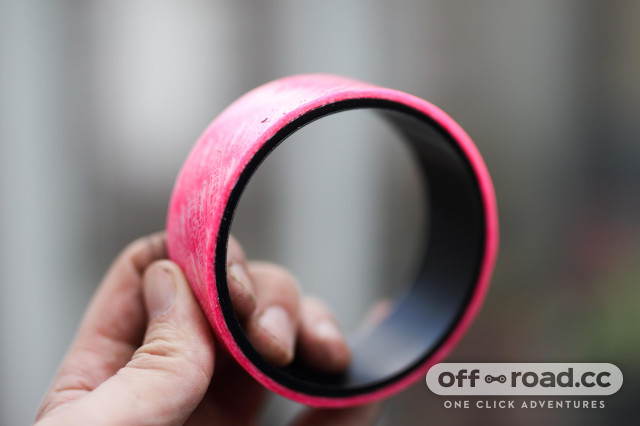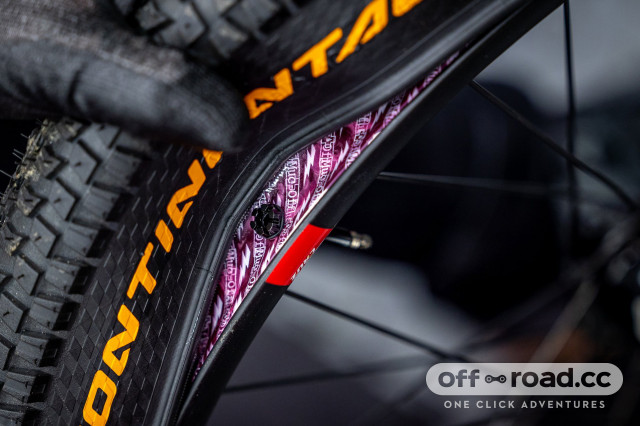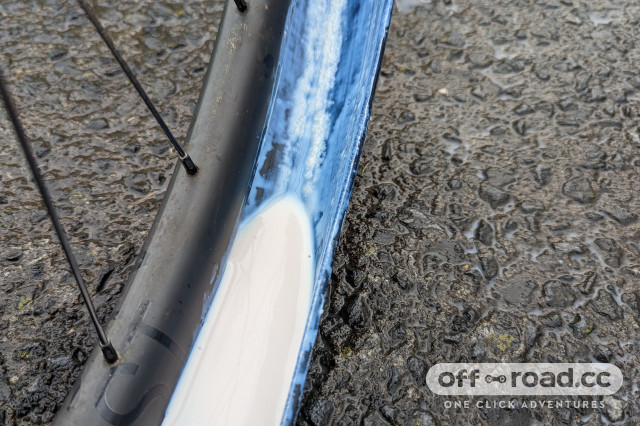How does tyre sealant work?

The benefits of tubeless tyres include greater puncture resistance and better low-pressure performance, enhancing grip and making every gravel adventure or singletrack descent a more rewarding experience. Three components are key to a successful tubeless tyre installation but one ensures a solid seal of both rim and tyre over a long period of time - tyre sealant.
- Best tubeless sealant 2023 - tyre sealant for MTB, gravel and road
- Tubeless mountain bike tyres - everything you need to know
- Is it worth converting your mountain bike to tubeless?
It's possible to set up tubeless tyres without sealant but there's one key reason why sealant is imperative – this magic tyre liquid allows tubeless tyres to reseal almost all kinds of punctures. And like any bike-based chemical fluid or lubricant, there’s a lot worth knowing about tubeless tyre sealant.
Why do I need sealant?
Off-road riding terrain is nearly infinitely variable. All those rocks, roots and loose bits of shale are impossible to model and account for, even if tyre designers use the most powerful engineering software. That means potential puncture risks are everywhere.
For all kinds of riders, thorns are a classic culprit of a puncture but for mountain and gravel riders who ride off-road, they're an even more common enemy. Less visible than sharp rocks when trail scanning, thorns can become a veritable puncture nightmare, overwhelming a tyre’s ability to hold air.
Mountain and gravel bike riders are susceptible to punctures due to the diversity and texture of terrain surfaces they roll over, and the relatively low tyre pressures they run to enhance grip and ride comfort. When descending a trail at speed, terrain impacts caused by rocks and roots can pinch flat your tyre, by squeezing it against the rim's hooks (the bits that keep your tyre's beads in place). This is one area where tubeless tyre sealant works its chemical magic: by flowing to that pinch flat hole while rolling along and sealing it by reacting with the air.
Although most sealants are latex-based, the formulations also contain microparticles and crystals, which coagulate to help fill a puncture while you are rolling along as the liquid dries to form the seal, instead of merely emptying all fluid onto the trail.
Rim shape and sealant
Not all rims are similar in shape and the diversity of rim profiles and structures triggered much frustration in the early days of tubeless tyre adoption. Some tyre brands and rims were enormously frustrating to try and seat, not to mention seal due to large variations in tyre and rim standards.
In recent years, those standards have gotten much better, plus advancements in rim bed designs with rim bed locks and similar techy goodness have led to tubeless setups that are simply easier to set up.
Even though there are many non-tubeless or cycling-specific tapes that will hold a seal, it's best to steer clear of Gorilla Tape and electrical tape as they can leave a hellishly sticky residue that'll be tough to remove and result in a poor seal when the time comes for a refresh.
Tubeless rim tape is made to be less porous than traditional rim tape, preventing sealant and associated moisture from seeping where it shouldn’t, and possibly corroding your spokes. You want the best airtightness for your rim and tyre combination; tubeless rim tape is integral to that. Its adhesive qualities aren't as potent as domestic use gaffer tapes too, so it's easy enough to remove and shouldn't leave residue.
Sealant and the issue of clogged valves
The tubeless tyre system and its integrity regarding airtightness and puncture resistance rely on appropriate rim design, correct rim tape, sealant and valves. Incorrectly configure any of these, and it will become the system’s weakness and leave you with the frustration of a tyre that doesn’t hold your desired air pressure as intended.
Valves can become sticky, constricted or entirely blocked by tyre sealant. It’s one of those annoyances of legacy valve design, which has not always kept trend with the fluid realities of tubeless tyre system requirements.
Investing in a pair of premium tubeless valves isn’t expensive (£20 to £30), and these valves last a long time. Some feature machined slots at the valve base, which are designed to help sealant flow when it's injected through the valve stem with a tyre insert installed.
How long does sealant last?
Like any advanced mountain or gravel bike technology, sealant isn’t maintenance-free. Over time, sealant can thicken and form into clumps. Once your sealant has ‘aged’ and changed its form into small clumps, instead of a responsive fluid, it won’t seek and seal pinch flats or other puncture issues.
A sealant's longevity depends on several factors, including riding frequency and temperature. But for most mountain bikers and gravel riders, it’s best to check the sealant every three months and to replace it every six. However, this is specific to the manufacturer, so check the bottle before breaking into the tyre. But a good rule of thumb is that if it's still in its liquid state, it's good. If it's lumpy, get that sealant changed.
It's worth noting that the use of CO2 canisters, chosen to quickly inflate and seal a tyre after a puncture, has an effect on many tubeless sealants. When activated and burst into a tubeless setup, an endothermic reaction takes place, where both the canister and CO2 get incredibly cold and this can freeze a tyre sealant. There are some brands that offer a sealant that is CO2 friendly, where this effect shouldn't happen. Either way, remember that CO2 inflation is a get-me-home measure at best and should be replaced with bog standard air because CO2 will also seep through the tyre's construction.
What about sealant and environmental stewardship?
A lot of mountain bikers and gravel riders are environmentalists by implication. Without pristine forests and healthy wilderness areas, there’s no rewarding singletrack or ranging weekend adventure rides. But is the sealant inside your tyres toxic to the environment?
For riders who are deeply aware of their environmental impact, spilling sealant from a tyre that has squirmed off a rim during a high-speed cornering is messy and alarming. Most sealants are latex or synthetic, with other additives kept secret by manufacturers. Latex, especially in its liquid form, will degrade reasonably quickly.
Most of the industry uses a variety of biodegradable particles in their sealant formulations but there are alternatives for those riders who want to use an environmentally conscious sealant. Some brands have invested in formulations that offer all the required product stability and attributes without the perceived toxicity of traditional latex-based sealants and without using ammonia, a common ingredient of tubeless sealants.















4 comments
It "reacts with the air." Quite the in-depth chemistry lesson.
Bogies! It forms bogies that block holes in the tyre.
Doesn't say how sealant works???
Doesn't say how sealant works???